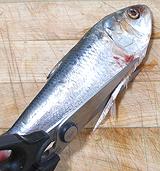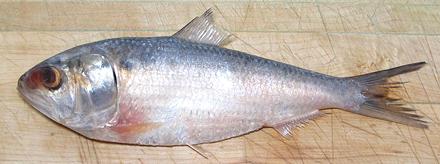
Cutting off the keel
|
This herring is fairly mild in taste compared to some other herrings,
with good flavor and less oil than most. On the other hand, it is a
very difficult fish to enjoy. It is totally shot through with bones, fin
rays and thread-like spines. Even the hard keel has hard, bone-like
fin rays going upward, meshing with the ribs coming down.
Cooking: Cooking whole or pan dressed, by any method,
is futile. I eat fish with chopsticks so I can disassemble them
very precisely, and I'm used to bony fish, but even I had a hard time
eating these, fried or steamed.
I filleted some of these fish and found if I fried a fillet, lightly
dusted with rice flour, until nice and golden brown on both sides, only a
few spines were noticeable, at least for a fish 8 inches or smaller.
I tried cooking fillets as a Philippine adobo (with vinegar), but
the cooking time wasn't long enough to soften the spines and the result
wasn't real pleasant. Next time I get some I'm going to try a ceviche,
an overnight soak in lime juice will probably soften the spines
sufficiently. Otherwise, the fallback, as for other small herrings, is
to pickle them - or use them for bait.
Scales: This fish is completely covered with rather
large thin scales. They have moderate adhesion so are not difficult to
scrape off and don't fly around much, but some of them in the middle
of the fish will just capsize rather than scrape off, so you'll have
to pick those off by hand. The scales are so transparent it's difficult
to tell if you got thm all.
Cleaning: This fish has a hard keel all along the
bottom, so there's no entry point for cleaning. Easiest is just to
cut off the head and use your little finger to scoop out all the stuff.
Otherwise, cut off the bottom from the vent forward to under the chin
with kitchen shears, as shown in the photo to the left, but take a bit
more than shown, at least 1/4 inch. After this it can be opened and
cleaned the usual way as shown in Cleaning
and Filleting Fish.
Fillet: Filleting is a little more difficult than for
many fish, especially making sure you're on the right side of the bones
when cutting down from the top. When you've cut down over the backbone,
cut to the bottom at the tail, then just pull the fillet off the bones
going forward. The flesh you lose there is too shot full of bones to
eat anyway. Trim off the flap of skin that was over the ribs. You'll
notice the fillet is very prickly, but there's nothing you can do about
that.
Yield: A 5-1/4 ounce fish will yield about 1-1/2 ounce
of fillet. That's just 29%, not real good. It's a real low cost fish,
but even at 2014 US $1.24 per pound, you're now at $4.28 per pound for
edible meat.
Skin: The skin doesn't shrink noticeably, but in any
case it's so thin and fragile it couldn't do much damage even if it did.
There is no sense trying to skin this fish.
Stock: Heads and bones make a stock that smells rather
strong, and still tastes oily even after you've carefully removed
any oil. Not recommended.
|

 [Pacific Thread Herring; Opisthonema libertate -
Atlantic Thread Herring; Opisthonema oglinum]
[Pacific Thread Herring; Opisthonema libertate -
Atlantic Thread Herring; Opisthonema oglinum]